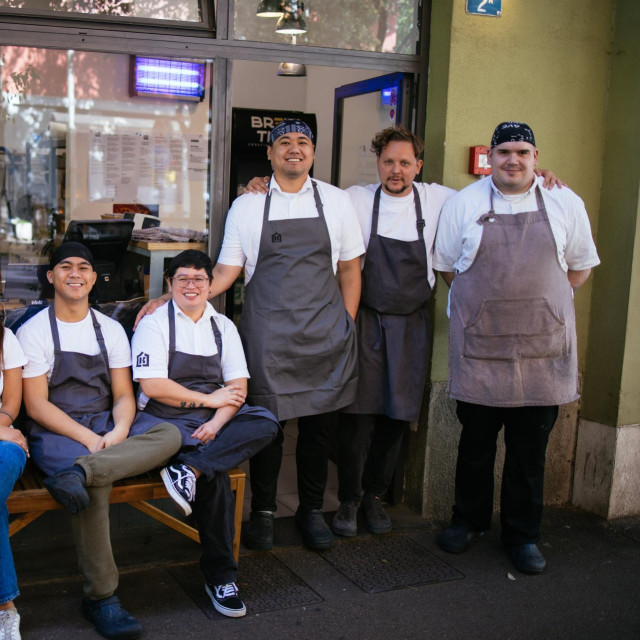In Asia, there really is an enormous variety of noodle types. They are not just food – they are culture, a symbol of longevity and happiness, and each country proudly preserves its own version: from thin vermicelli in Vietnam, wide udon strips in Japan, to glassy starch noodles in China.
In a conversation with Marko Flego from Rijeka’s street food Koya, we learned how to navigate this forest of noodles and, even more importantly, how to make the best ones for almost every Asian dish – from wok to ramen.
Although Koya initially developed their noodles patiently by hand, they now use a large modern machine in this dedicated process, skillfully adapting them to different dish styles. At first, they used wheat flour, water, salt, and egg, but soon decided to omit the egg so their noodles would also be suitable for vegans.
"Our goal was to make a ‘democratic noodle’ that everyone can eat," Marko shared with us.
And so, they started making dough with low hydration – meaning, with less water, resulting in a firmer dough. Such dough is a real challenge to process without a powerful machine, but it bravely handles the task – running it through rollers, spreading it into thin sheets, and then cutting it into noodles. Previously, they used three different machines – a mixer, a roller, and a cutter – but today, one large, powerful machine does it all.
To experience that magical difference in texture firsthand, Marko presented us with dishes featuring their characteristic noodles. First to arrive at the table were Sichuan spicy dandan noodles, where they use the same type of noodles as for stir-fry – lo mein style noodles, without egg, ideal for dishes that require the true speed and power of the wok. "These noodles are thin but firm, they don’t fall apart in the dish and can even survive delivery," Marko explains with a smile.
The second dish was enticing ramen. For it, they use the same noodle base as for lo mein, but with the addition of wheat starch and gluten. This achieves that characteristic, pleasant ‘chewiness‘ and irresistible chewy mouthfeel, and the noodles slide smoothly through the rich broth – which is key for that well-known, satisfying slurping, without which ramen isn’t ramen.
I’ve never been a fan of that typical smell of store-bought ramen noodles, so we don’t use alkaline salts – starch is a better option, without that artificial smell, Marko explained, referring to the scent that store-bought ramen noodles often get from alkaline salts like baking soda.
When we asked him what the secret to a good noodle really is, Marko was clear: low dough hydration, firm structure, and adaptation to the dish. Noodles must bravely withstand a hot wok without falling apart, and in ramen soup remain elastic until the last, delicious bite. At Koya – they proudly emphasize – they do everything themselves.
In the end, as we sat enjoying a full plate of dandan noodles and diligently slurped ramen, we clearly felt that special difference. Of course, it’s almost impossible to describe all the techniques and variations of noodle making that exist across Asia. But, judging by the wonderful dishes we tasted at Koya, mastering these two basic types – those for wok and those for ramen – is more than enough. It’s a great starting point for anyone who wants to dive into the world of homemade Asian noodles. Because, as we’ve learned, to make good noodles you need flour, water, salt… but above all a lot of knowledge, patience, and love for this simple yet incredibly important ingredient.
LO MEIN NOODLES
You will need:
297 g type 00 wheat flour
3 g salt
1 large egg
77 g lukewarm water
Preparation:
In a small bowl, dissolve the salt in the water and add the egg. Pour the flour onto your work surface and shape it into a ring with a well in the center (the so-called “volcano”). Slowly pour the water and egg mixture into the well and gradually mix in the flour with your fingers in a circular motion until you get a cohesive dough. Knead the dough until it becomes smooth and elastic. Wrap it in plastic wrap and let it rest for 30 minutes at room temperature. For rolling the noodles, use a classic pasta machine. First, gently flatten the dough with your palm, then run it twice through the widest setting (usually marked as “0”). Then gradually decrease the thickness, folding the dough each time and running it through again, until you reach the desired thickness. For best results, use a thickness of 1.5 mm. When you are satisfied with the thickness, cut the dough into the desired shape (round or flat noodles). Lightly dust them with flour or corn starch so they don’t stick. Portion into 100 g or 200 g piles.
ADDITIONAL TIP
You can cook the noodles immediately, but the ideal flavor is achieved when they rest in the fridge for one to two days. If you cook them later, gently arrange them in a container, cover with baking paper, and let them breathe. Before cooking, take them out of the fridge to bring them to room temperature, then cook in boiling water to the desired texture.







Za sudjelovanje u komentarima je potrebna prijava, odnosno registracija ako još nemaš korisnički profil....